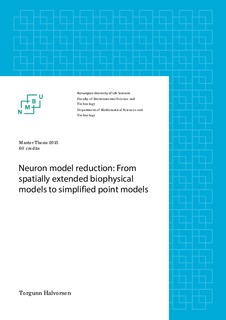| dc.description.abstract | The response of a real neuron to a single synaptic input will depend on where on its dendritic tree the synapse is placed. The synaptic response is a voltage deflection generated at the synapse location in a synapse and then propagates from the synapse to the soma, where the membrane potential is typically measured. If the voltage deflection in the soma reaches a certain threshold value the neuron may generate an action potential, which is an output signal to other neurons. The distance from where the synaptic response is generated and propagates to the soma, decides the amount of weakening and change in shape the signal experienced before measured in soma. Real neurons will therefore have a diversity of somatic responses to a single synaptic input, depending on the synaptic location.
In network simulations the use of single compartment models (point models), are customary. A point model lacks the spatial aspect of a morphological spacious neuron model. A point model has only one option for synapse placement, directly at its soma (i.e., its single compartment). The diversity of synapse responses a spacious neuron model can achieve in its soma is not captured by the point model in a trivial way.
The goal of this project is to create a synapse model for a passive point neuron, that can account for the diversity of somatic responses obtained in spatially explicit neurons.
“Realistic” somatic responses were obtained by placing synapses at different locations in a previously published multicompartmental neural model which was taken to represent a “real” neuron. The synaptic response obtained for a given synapse location was then recreated in a point model. This was done by using curve fitting methods: Four parameters in the point neuron synapse were varied to obtain an optimal fit from the response in the “real” neuron. This was repeated for all possible synapse locations in the realistic neuron's morphology.
The result was two synapse models for a point neuron. One easily implemented and applied, and one more accurate, but containing more results. The synapse was described by four parameters, each of which were functions of a single variable d, representing the synaptic distance from the soma in the realistic neural model. In this way, the variability in somatic response that in real neurons follow from variability in synaptic position, could be captured by varying a single parameter in a synapse placed at a point model. These synapse models will contribute to more realistic modelling of sub-threshold dynamics for point neurons. | nb_NO |
